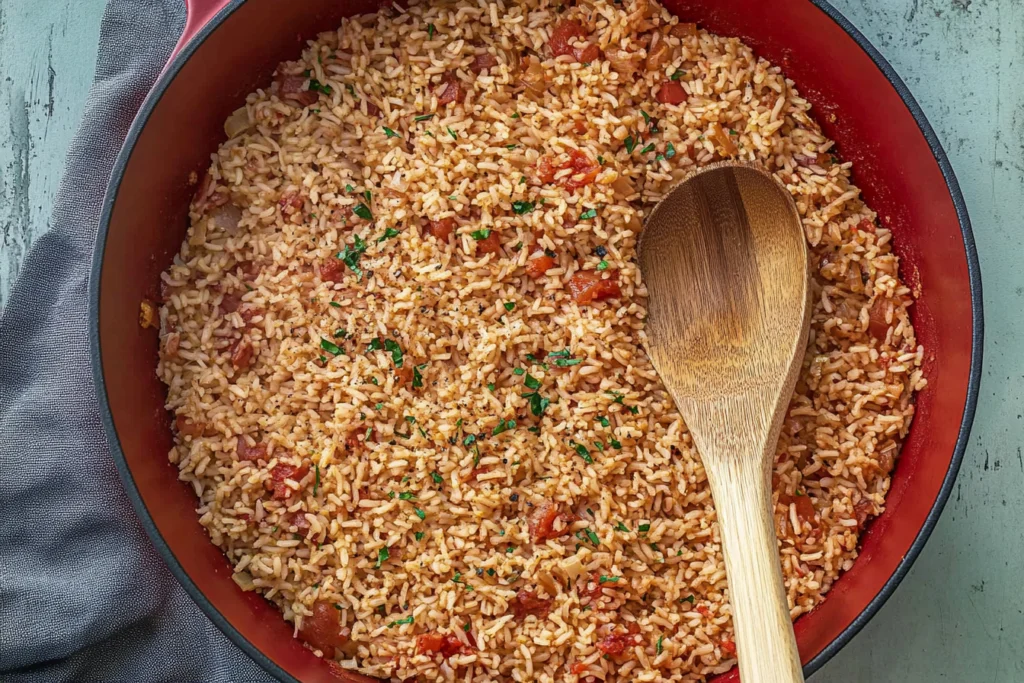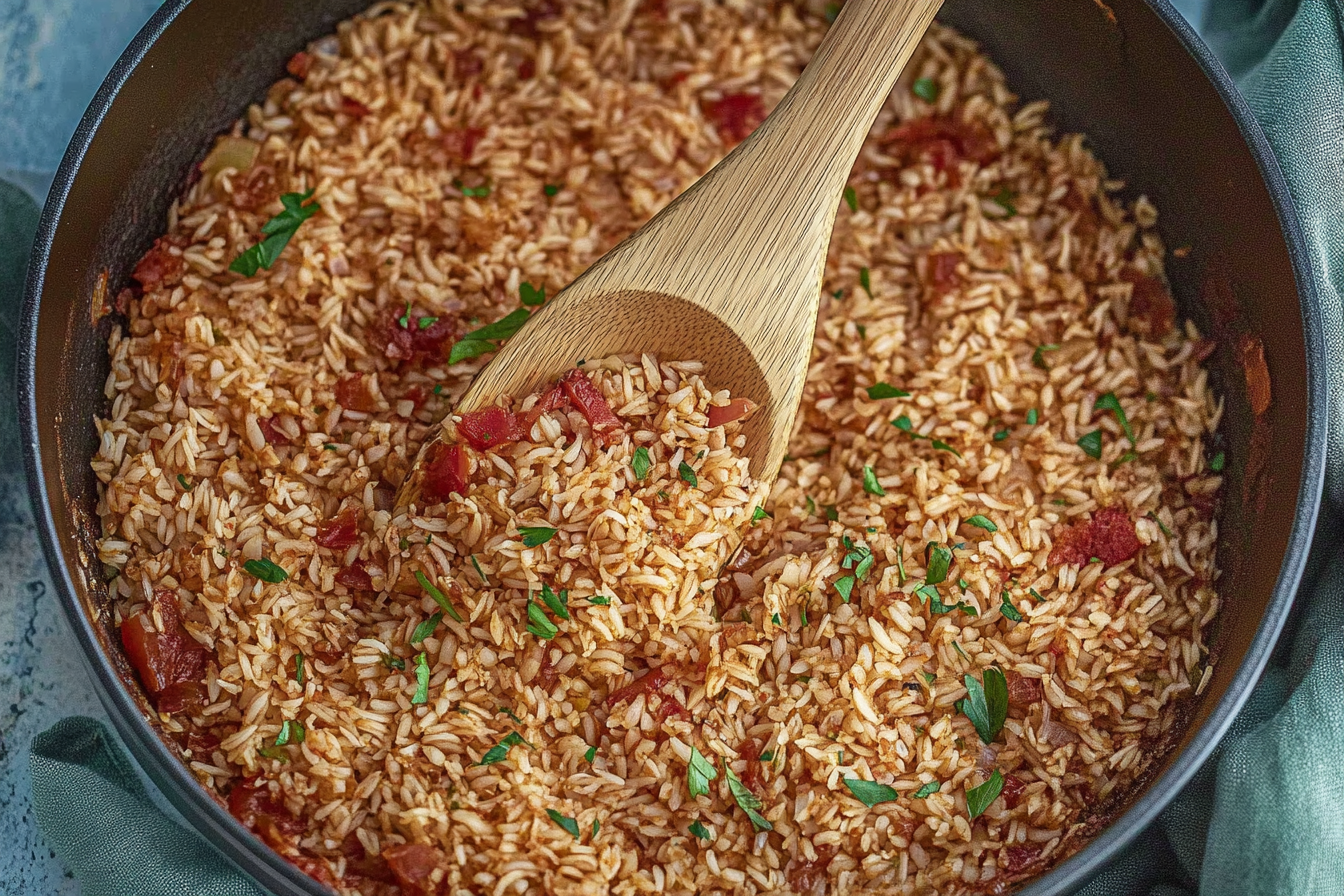Introduction
Red rice, with its vibrant color and rich nutritional profile, is a grain that’s slowly gaining global attention. But how is red rice made? From its cultivation to its final, flavorful dishes, the process is both fascinating and rewarding. Whether you’ve tried it before or you’re just curious about this healthy alternative to white rice, this article takes you through every step of its journey. From how red rice is harvested to the different ways you can cook it, we’ll explore all the essential details, health benefits, and culinary tips. So, let’s dive into this deliciously nutritious world of red rice!
Table of contents
What is Red Rice? Exploring the Basics of This Unique Grain
Understanding What Red Rice Is?
Red rice, unlike the more common white rice, retains its reddish-brown husk after milling. This gives it a rich, earthy flavor and a distinctive color. Unlike white rice, red rice isn’t stripped of its nutrients, which means it retains more fiber, antioxidants, and essential minerals. This makes red rice a superior choice for those looking to enjoy a healthy meal without sacrificing taste.
The grain itself can range in color from light pink to dark red, depending on its variety. Red rice is typically produced in areas where traditional farming methods are still widely practiced, such as Bhutan, Thailand, and parts of India. However, as more people discover its health benefits, it’s slowly making its way into other countries’ diets. In fact, many people are now choosing red rice over white rice due to its nutritional superiority and unique flavor profile.
Varieties of Red Rice
There are several varieties of red rice, each with its own distinct flavor and texture. For instance, the famous Bhutanese red rice is soft and slightly sticky when cooked, making it an ideal pairing for curries and stews. On the other hand, Thai red rice has a nutty, chewy texture, which pairs wonderfully with grilled meats and vegetables.
In addition to these, red rice can also be found in varieties like Cambodian red rice and Indian red rice (which is often called “Matta” rice). These varieties not only have different textures but are also used in different regional dishes. Some red rice is even grown organically, adding a layer of sustainability to its appeal.
Difference Between Red Rice and Brown Rice
At first glance, red rice may seem similar to brown rice, but there are some crucial differences between the two. Both red and brown rice are considered whole grains, which means they contain bran, germ, and endosperm. However, red rice tends to have a slightly nuttier flavor compared to brown rice, which is often described as mild or neutral.
In terms of nutritional value, red rice and brown rice are quite similar, offering a rich source of fiber, vitamins, and minerals. But where red rice stands out is in its high antioxidant content, thanks to its reddish hue. These antioxidants help fight oxidative stress in the body, promoting overall health.
Another difference between red rice and brown rice lies in their cooking times and textures. Red rice tends to cook a bit longer than brown rice, and once cooked, it has a chewier, firmer texture. While brown rice can sometimes be a little mushy if overcooked, red rice maintains its structure better, making it a great choice for salads and pilafs.
The History and Cultural Significance of Red Rice
Red rice has a long and rich history, particularly in Asia. It’s been cultivated for thousands of years, often in regions where rice farming is deeply embedded in the culture. In countries like Bhutan, red rice isn’t just a food item—it’s a symbol of prosperity and community.
In fact, Bhutanese red rice has played a key role in the country’s cuisine, often served alongside traditional dishes like Ema Datshi (a spicy chili and cheese stew). Similarly, red rice is often featured in Thai and Indian dishes, where it’s used to complement robust flavors in curries, dals, and stir-fries.
Culturally, red rice has become a symbol of sustainable farming practices. Unlike white rice, which requires significant processing to remove its husk, red rice is often grown using more traditional and environmentally friendly methods. This makes it a popular choice for those seeking to make more eco-conscious food choices.

The Process of Making Red Rice
Now that we’ve explored the basics of red rice, let’s dive into the fascinating process of how it’s made. From the conditions under which it grows to the techniques used for harvesting and processing, understanding this journey will help you appreciate this nutritious grain even more. Let’s break it down step by step.
How Red Rice is Harvested
Growing Conditions for Red Rice
Red rice is typically grown in specific conditions that support its growth and development. This grain is not just any rice; it requires particular climate and soil conditions to thrive.
- Climate and Soil Requirements
Red rice prefers tropical and subtropical climates, where it can soak up plenty of sunlight and warmth. These regions often experience ample rainfall, which is vital for rice cultivation. Ideal temperatures for growing red rice range between 75°F and 95°F (24°C to 35°C). The soil needs to be fertile, well-drained, and slightly acidic.In terms of water management, red rice is usually grown in flooded paddies, a method common for many rice varieties. However, it can also adapt to dryland conditions in some areas, making it more versatile in different farming environments. - Regions Where Red Rice is Primarily Cultivated
This grain is predominantly cultivated in parts of South Asia, Southeast Asia, and East Asia. Countries like India, Thailand, Cambodia, and Bhutan are well-known for producing red rice. In Bhutan, red rice is not just a staple food; it’s also an integral part of the country’s cultural heritage. In other regions like Southern United States, red rice varieties like Savannah red rice are grown, adding a Southern twist to the grain’s legacy.
Harvesting Techniques
When it comes to harvesting red rice, there are distinct differences in approach, depending on the scale and type of farm.
- Manual vs. Mechanized Harvesting
In small-scale farms, especially in rural areas, red rice is often harvested manually. Farmers use sickles or hand tools to cut the rice stalks when they’re fully mature. This method allows for careful selection and ensures that the crop is harvested at its peak quality. Manual harvesting is also quite labor-intensive, but it’s an important part of the traditional farming process.On the other hand, large-scale operations may use mechanized harvesters to speed up the process. These machines can cut, thresh, and clean the rice in one go, making them ideal for mass production. While mechanized harvesting is more efficient, it can sometimes lead to a loss in quality, as it’s harder to control the exact timing of the harvest.
How is Red Rice Processed?
Once red rice is harvested, it goes through several stages of processing before it’s ready to be cooked and enjoyed. Unlike white rice, which undergoes extensive milling to remove its husk and bran, red rice is processed in a way that retains much of its nutritional value.
Milling Process of Red Rice
Red rice undergoes minimal processing compared to white rice. The key difference lies in how the rice is milled. Red rice grains are usually only husked, removing the outer shell while leaving the bran intact. This is why red rice has such a rich color and is so much more nutritious than white rice.
In white rice production, the bran is stripped away, which also removes many of the essential vitamins and minerals. However, red rice retains its bran layer, providing more fiber, antioxidants, and essential fatty acids. This means that when you eat red rice, you’re consuming a much more nutritious option than white rice.
- Comparison with White Rice Processing
As we mentioned, the main difference between red and white rice processing is that red rice keeps its bran. White rice is polished and refined, while red rice is simply husked and lightly processed. This method preserves its healthful properties, making it a popular choice for those seeking whole-grain options.
Washing and Soaking Red Rice
Washing and soaking red rice are crucial steps in the preparation process, and they can impact the final texture and cooking time.
- Impact on Cooking Time and Texture
Red rice typically requires a longer cooking time compared to white rice, partly due to its thicker bran layer. By washing the rice thoroughly, you can remove excess starch, which helps the rice cook more evenly. Soaking the rice for about 30 minutes before cooking can reduce the overall cooking time, as it allows the rice to absorb water more quickly. - Why Soaking is Important
Soaking red rice isn’t just about saving time it’s about improving the texture. The soaking process softens the grain and makes it more tender once cooked. This is especially useful for dishes where the rice is intended to be fluffy, such as pilafs or salads. Additionally, soaking enhances the digestibility of the rice and helps in breaking down any natural phytic acid, which can inhibit the absorption of some minerals.

Cooking Methods for Red Rice
Red rice can be cooked in a variety of ways, depending on your preferences and the dish you’re preparing. Here are a few methods that will help you perfectly prepare red rice at home.
Basic Cooking Methods
- Stovetop, Pressure Cooker, and Rice Cooker
Red rice can be prepared using various methods, with the stovetop being the most common. However, if you’re looking for a quicker cooking time, you can also use a pressure cooker or rice cooker. Each method has its advantages:- Stovetop: Simple and traditional, but it requires a bit more attention and a longer cooking time.
- Pressure Cooker: Ideal for reducing cooking time. The rice can cook in around 20 minutes, but make sure to adjust the water levels accordingly.
- Rice Cooker: The easiest method, especially if you’re looking for hands-off preparation. A rice cooker automatically adjusts cooking time and temperature, ensuring perfectly cooked rice every time.
- Cooking Ratio: Water to Rice
For stovetop cooking, a general guideline is a 2:1 ratio of water to red rice. That means for every cup of red rice, you’ll need about two cups of water. However, since different varieties of red rice may require slightly different amounts of water, it’s important to adjust based on the type you’re using.
Flavoring Red Rice
One of the most exciting things about cooking red rice is the ability to add extra flavors to enhance its taste. Red rice has a naturally earthy, nutty flavor, but it can easily be enhanced with the right additions.
- Common Additions Like Spices, Broths, and Herbs
You can cook red rice in a vegetable or chicken broth instead of plain water to infuse it with deeper flavor. For a more aromatic dish, consider adding spices such as cumin, coriander, or turmeric during the cooking process. Fresh herbs like cilantro or parsley can also be sprinkled on top for an extra burst of freshness. - How to Enhance Its Flavor Profile with Garlic, Onion, and Bouillon
Adding sautéed garlic and onion to your red rice before cooking it can elevate its flavor to the next level. For a savory touch, a bouillon cube or paste can be dissolved in the cooking water. This creates a rich, savory base that perfectly complements the rice’s natural nutty sweetness.
Different Red Rice Dishes from Around the World
Red rice is a versatile ingredient that is used in a variety of dishes around the world. Its unique flavor makes it ideal for both simple meals and more elaborate preparations.
Southern U.S. Red Rice (Savannah Red Rice)
A popular dish in the Southern United States, Savannah red rice is made with red rice, tomatoes, and bell peppers, often flavored with spices like cayenne pepper and paprika. This dish is often served alongside fried chicken or other Southern comfort foods.
Asian Dishes Featuring Red Rice
- Thai Red Curry with Red Rice
In Thailand, red rice is often paired with rich and aromatic curries. Thai red curry, with its coconut milk base, complements the earthy taste of the rice perfectly. - Cambodian Red Rice with Grilled Meats
Cambodian cuisine often features red rice served with grilled meats and vegetables. The rice acts as the perfect base, absorbing the smoky flavors of the grilled food.
Indian Red Rice Dishes
- Red Rice in Biryani and Kheer
In India, red rice is often used to make biryani, a spiced rice dish typically served with yogurt or raita. It’s also used in kheer, a traditional rice pudding dessert, where the rice’s nutty flavor pairs well with the sweetness of milk and sugar.
In the next part, we’ll explore more details about the health benefits of red rice and how it stacks up against other grains.
FAQs
- What is red rice made of?
Red rice is made from whole rice grains that retain their reddish-brown husk, which gives them their distinct color. Unlike white rice, which is stripped of its outer layer, red rice retains the bran and germ, making it a more nutritious option. It’s rich in fiber, antioxidants, and essential nutrients, which contribute to its health benefits. - How is red rice grown?
Red rice is typically grown in tropical and subtropical climates, where it thrives in flooded paddies or in dryland conditions. It requires fertile, slightly acidic soil and ample rainfall. Countries like India, Thailand, Cambodia, and Bhutan are known for cultivating red rice. The rice grows in warm temperatures and can be harvested either manually or with mechanized tools, depending on the farm’s scale. - Is red rice really good for you?
Yes, red rice is an excellent choice for health-conscious individuals. It’s packed with fiber, antioxidants, vitamins, and minerals, making it a superior option to white rice. The retention of the bran layer in red rice provides more nutrients, including essential fatty acids and iron. It’s also a low glycemic index food, which means it can help regulate blood sugar levels and support digestive health. - What causes red rice to be red?
The distinctive red color of the rice comes from anthocyanins, a type of antioxidant. These antioxidants are responsible for the vibrant color and provide health benefits by helping to fight oxidative stress in the body. The red hue is a natural feature of the rice’s bran layer, which is left intact during milling, preserving both its color and its nutrients.

Conclusion
Red rice is more than just a visually striking grain—it’s a nutritional powerhouse that offers a range of health benefits. From its rich color caused by antioxidants to its high fiber content and the variety of ways it can be incorporated into your meals, red rice is an excellent addition to any diet. Whether you’re using it in traditional dishes or experimenting with new recipes, it’s a versatile and wholesome ingredient.
We’ve covered everything from how red rice is made, to the growing conditions, and its unique nutritional benefits. Now that you know the full process from cultivation to cooking you can confidently add this super-grain to your pantry. Enjoy experimenting with its flavor and texture in dishes from around the world, and reap the health rewards it brings!

